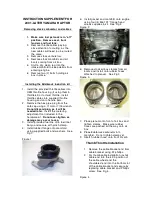
To remove the layer of salt:
R
apply the brakes from time to time, paying
attention to traffic conditions
R
carefully depress the brake pedal at the end
of a journey and after the start of a new jour‐
ney
Checking the brakepad thickness
In addition to monitoring using the brakepad wear
sensor, regularly monitor and check all of the
brakepads by performing a visual inspection to
look for pad material wear.
If you are unable to check the brakepad wear on
the inside of the wheels, remove the wheels if
you possess the required skills, or visit a qualified
specialist workshop.
If the brakepad material thickness is less than
0.12 in (3 mm), have the brakepads checked and
replaced at a qualified specialist workshop, if
necessary.
Do not solely rely on the brakepad wear sensor.
It is also strongly recommended that you have
the brakepads checked at a qualified specialist
workshop, not only at every service displayed by
the maintenance interval display, but also prior to
long journeys and whenever the wheels are
removed.
New brake discs and brakepads
New brakepads and brake discs only reach their
optimal braking effect after approximately
100 miles (100 kilometers).
Until then, compensate for the reduced braking
effect by applying greater pressure to the brake
pedal. For safety reasons, Mercedes-Benz recom‐
mends that you only have brakepads and brake
discs which are approved by Mercedes-Benz
installed on your vehicle.
Other brake discs or brakepads may compromise
the safety of your vehicle.
Always replace all brake discs and brakepads on
an axle at the same time. Always install new
brakepads when replacing brake discs.
Parking brake
&
WARNING Risk of skidding or an acci‐
dent by braking with the parking brake
If you have to brake your vehicle with the
parking brake, the braking distance is consid‐
erably longer and the wheels may lock. There
is an increased risk of skidding and/or acci‐
dent.
#
Only brake the vehicle with the parking
brake if the service brake has failed.
#
In this case, do not apply the parking
brake with too much force.
#
If the wheels lock, immediately release
the parking brake as much as required
for the wheels to turn again.
Vehicles with a manual parking brake
When driving on wet roads or dirt-covered surfa‐
ces, road salt or dirt may get into the parking
brake. This causes corrosion and a reduction of
braking force.
In order to prevent this, drive with the parking
brake lightly applied from time to time.
When doing so, drive for a distance of approx‐
imately 300 ft at a maximum speed of 13 mph
(20 km/h).
The brake lights do not light up when you brake
the vehicle with the parking brake.
Information about driving on wet roads
Hydroplaning
&
WARNING Risk of aquaplaning because
tire tread is too low
Depending on the depth of the water on the
roadway, aquaplaning can occur despite suffi‐
cient tire tread depth and low speed.
#
Avoid tire ruts and brake carefully.
Therefore, in heavy rain or other conditions in
which hydroplaning can occur, drive as follows:
R
Reduce your speed.
R
Avoid tire ruts.
R
Brake carefully.
Driving on flooded roads
Bear in mind that vehicles traveling in front or in
the opposite direction create waves. This may
cause the maximum permissible depth of water
to be exceeded. These notes must be observed
under all circumstances. Otherwise, you can
damage the engine, electrics and transmission.
If you have to drive on stretches of road on which
water has collected, please bear in mind the fol‐
lowing:
R
The water level of standing water may not be
above the lower edge of the front bumper.
R
You may drive no faster than walking pace.
Driving and parking 109
Summary of Contents for Sprinter 2019
Page 7: ......
Page 19: ...ASpare wheel example 227 At a glance Emergencies and breakdowns 17...
Page 298: ......
















































